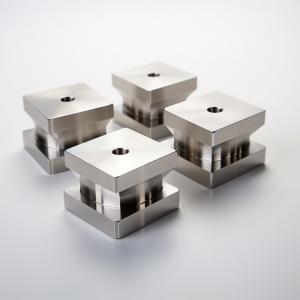

Add to Cart
CNC machining represents the predominant subtractive manufacturing technology in today's
industry, providing an exceptionally versatile and robust method for crafting personalized metal
and plastic parts. Utilizing CAD models, CNC machines precisely eliminate material from solid blocks
using various cutting tools.
Product Details
The CNC machining process predominantly employs metals as its primary materials.
These metals encompass alloy steel, carbon steel, cast iron, stainless steel, aluminum, copper,
magnesium, and zinc.
Nonetheless, this versatile process can also be applied to machine plastic components and work
with an array of other materials, including ceramics, composites, thermoplastics, and thermosets.
| Common Materials | |
| Name | Description |
| Aluminum | High machinability and ductility, good strength-to-weight ratio. |
| Stainless steel | High tensile strength, corrosion and temperature resistant. |
| Mild steel | High machinability and weldability, high stiffness. |
| Brass | Low friction, excellent electrical conductivity, golden appearance. |
| Copper | Excellent thermal and electrical conductivity. |
| Titanium | Excellent strength to weight ratio, used in aerospace, automotive and medical industries. |
| ABS | Common thermoplastic, impact resistant, easy to machine. |
| Nylon | Excellent mechanical properties, thermal, chemical and abrasion resistant. |
| POM | High stiffness, high accuracy, low friction, easy to machine. |
Post-processing and surface finishes for CNC machining
CNC-machined parts as they emerge from the machine often exhibit visible tool marks,
a feature that may not align with your specific part requirements.
Fortunately, there exists a multitude of post-processing techniques aimed at enhancing the
surface appearance and elevating attributes such as wear resistance, corrosion resistance,
and chemical resistance.
Methods like anodizing, bead blasting, and powder coating present viable options for refining
the final presentation of your custom parts, allowing you to achieve the desired surface
quality and performance characteristics.
| Surface Finishes | ||
| Name | Applicable to | Machining marks |
| As machined | Metals, Plastics | Visible, light surface scratches |
| Smooth machining | ||
| Fine machining | Metals | Slightly visible |
| Polishing | Metals | Removed on primary surfaces |
| Bead blasting | Metals | Removed for non-cosmetic, removed on primary surfaces for cosmetic |
| Brushing | Metals | |
| Anodizing Type II | Aluminum | |
| Anodizing Type III | Aluminum | Visible under anodizing |
| Black oxide | Copper, Stainless steel, Alloy steel, Tool steel, Mild steel | Visible |
| Powder coating | Metals | Removed |
| Brushed + electropolishing | Stainless steel | Removed on Primary surfaces |
Specialist Industries
CNC milling, renowned for its precision, is a versatile manufacturing technique with a wide range
of applications. Common uses include:
1. Aerospace Components: Precision machining for the creation of
intricate parts, ensuring reliability
and safety in aerospace applications.
2. Furniture: Crafting precise components for furniture, ranging
from ornate designs to functional pieces.
3. Medical Components: Manufacturing critical parts for medical
devices and instruments, meeting
stringent standards for quality and accuracy.
4. Prototypes: Rapid prototyping for product development, allowing
efficient testing and iteration of
designs.
5. Titanium Pieces: Machining of titanium components, known for its
strength and durability, often
used in aerospace and medical applications.
6. Woodworking: Precision woodworking to create finely detailed and
finished wooden components.
These applications showcase the versatility of CNC milling, making
it a go-to technology for industries
that demand accuracy and complexity in their manufactured parts.
Company Profile
FAQ's
1. What if I am not completely satisfied with the parts I receive?
We stand by the quality of our materials and workmanship, adhering to the terms outlined in the
initial order and the details provided by you. Should any disputes arise based on subjective
evaluations, our management will be notified to address them in good faith, striving to ensure
your complete satisfaction. Our ongoing business success is contingent on earning your trust in
our ability to consistently meet and exceed reasonable expectations.
2. Do you offer Quick-Turn CNC Machining?
Yes, we specialize in Quick-Turn CNC Machining, ensuring swift lead times for parts, with many
ready in just 3-4 days. Our services include an expedite option, and our team works closely with
you to fulfill your most time-sensitive requirements.
3. What are the minimum and maximum dimensions you can machine?
Our comprehensive CNC machining services cover milling (3-axis, 3+2-axis, and 5-axis) and
turning processes. In 3/3+2-axis CNC milling, we can achieve part dimensions up to
2000 x 1500 x 200 mm (78.7 x 59.0 x 7.8 in.). For 5-axis milling, the maximum part size is
650 x 650 x 300 mm (25.5 x 25.5 x 11.8 in.).
CNC turning accommodates a maximum diameter of 431 mm (17 in.) and a length of 990 mm
(39 in.). Smaller parts are recommended to have dimensions around 10 x 10 x 10 mm
(0.39 x 0.39 x 0.39 in.), with a minimum feature size of 0.5 mm.
It's important to be aware that our platform imposes a maximum part size of 1000 mm (39 in.),
and for larger requirements, we encourage you to contact our sales team for tailored support.
4. What cosmetic standards do you guarantee?
Upholding stringent quality standards, our CNC machined parts undergo standard deburring and
edge-breaking procedures. Clear indications in technical drawings are required for any critical edges
that should be left sharp.
Surfaces are guaranteed to be defect-free, ensuring the absence of scratches, dents, stains,
blemishes, hanging marks, and minor imperfections. Critical surfaces (primary (a) side, as outlined
in technical drawings) will be meticulously free from mill steps and other marks. On the secondary (b)
side, minor hanging marks and up to 2 minor defects are considered within acceptable limits.
Additionally, a range of post-processing and finishing methods can be applied to enhance surface
roughness, visual aesthetics, and wear resistance for CNC machined parts.
